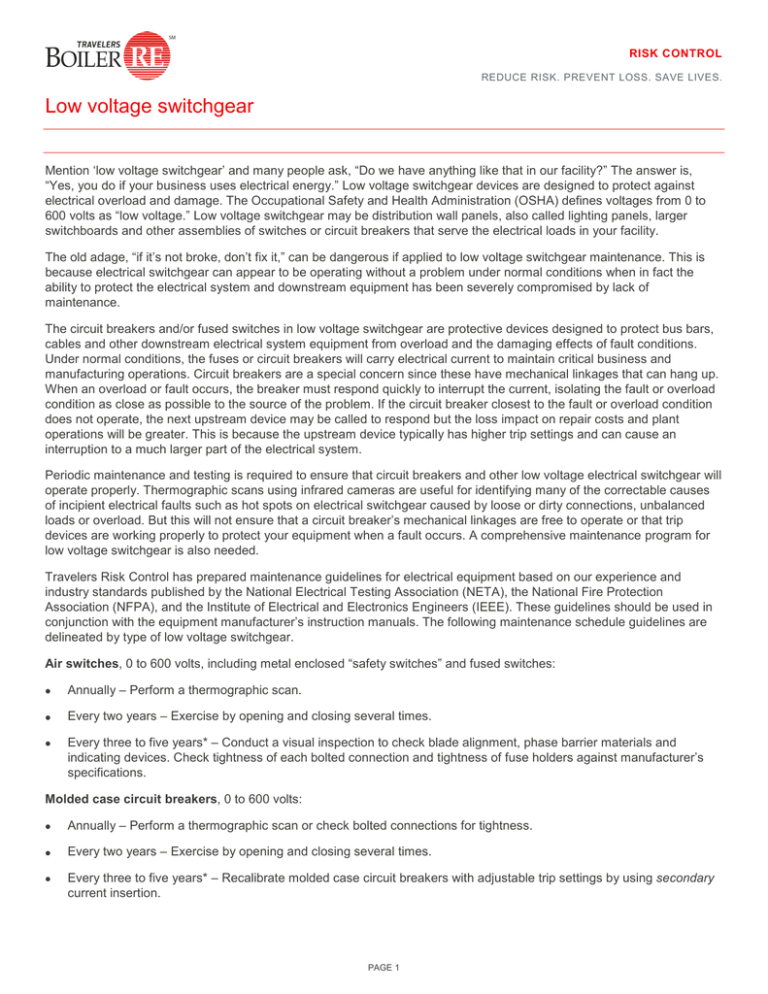
RISK CONTROL
REDUCE RISK. PREVENT LOSS. SAVE LIVES.
Low voltage switchgear
Mention ‘low voltage switchgear’ and many people ask, “Do we have anything like that in our facility?” The answer is,
“Yes, you do if your business uses electrical energy.” Low voltage switchgear devices are designed to protect against
electrical overload and damage. The Occupational Safety and Health Administration (OSHA) defines voltages from 0 to
600 volts as “low voltage.” Low voltage switchgear may be distribution wall panels, also called lighting panels, larger
switchboards and other assemblies of switches or circuit breakers that serve the electrical loads in your facility.
The old adage, “if it’s not broke, don’t fix it,” can be dangerous if applied to low voltage switchgear maintenance. This is
because electrical switchgear can appear to be operating without a problem under normal conditions when in fact the
ability to protect the electrical system and downstream equipment has been severely compromised by lack of
maintenance.
The circuit breakers and/or fused switches in low voltage switchgear are protective devices designed to protect bus bars,
cables and other downstream electrical system equipment from overload and the damaging effects of fault conditions.
Under normal conditions, the fuses or circuit breakers will carry electrical current to maintain critical business and
manufacturing operations. Circuit breakers are a special concern since these have mechanical linkages that can hang up.
When an overload or fault occurs, the breaker must respond quickly to interrupt the current, isolating the fault or overload
condition as close as possible to the source of the problem. If the circuit breaker closest to the fault or overload condition
does not operate, the next upstream device may be called to respond but the loss impact on repair costs and plant
operations will be greater. This is because the upstream device typically has higher trip settings and can cause an
interruption to a much larger part of the electrical system.
Periodic maintenance and testing is required to ensure that circuit breakers and other low voltage electrical switchgear will
operate properly. Thermographic scans using infrared cameras are useful for identifying many of the correctable causes
of incipient electrical faults such as hot spots on electrical switchgear caused by loose or dirty connections, unbalanced
loads or overload. But this will not ensure that a circuit breaker’s mechanical linkages are free to operate or that trip
devices are working properly to protect your equipment when a fault occurs. A comprehensive maintenance program for
low voltage switchgear is also needed.
Travelers Risk Control has prepared maintenance guidelines for electrical equipment based on our experience and
industry standards published by the National Electrical Testing Association (NETA), the National Fire Protection
Association (NFPA), and the Institute of Electrical and Electronics Engineers (IEEE). These guidelines should be used in
conjunction with the equipment manufacturer’s instruction manuals. The following maintenance schedule guidelines are
delineated by type of low voltage switchgear.
Air switches, 0 to 600 volts, including metal enclosed “safety switches” and fused switches:
•
Annually – Perform a thermographic scan.
•
Every two years – Exercise by opening and closing several times.
•
Every three to five years* – Conduct a visual inspection to check blade alignment, phase barrier materials and
indicating devices. Check tightness of each bolted connection and tightness of fuse holders against manufacturer’s
specifications.
Molded case circuit breakers, 0 to 600 volts:
•
Annually – Perform a thermographic scan or check bolted connections for tightness.
•
Every two years – Exercise by opening and closing several times.
•
Every three to five years* – Recalibrate molded case circuit breakers with adjustable trip settings by using secondary
current insertion.
PAGE 1
RISK CONTROL
Low voltage switchgear
Draw out type (metal frame) air circuit breakers, 0 to 600 volts:
•
Every two years – Exercise by opening and closing several times.
•
Every three to five years* – Draw out breakers to clean, inspect lubricate and repair as necessary, according to
manufacturer’s guidelines. Test and recalibrate electromechanical trip units by using primary current insertion. Solid
state trip devices should be tested using secondary current insertion or manufacturer’s test set, if applicable.
If it’s not broke… check it anyway. With electrical switchgear, you may not be aware of a problem until it is too late.
Routine maintenance is critical to help ensure proper operation of the important protective devices within the switchgear,
to help avoid severe damage to your electrical system and unplanned interruption to your business operations.
*Adjust frequency according to age and history.
To learn more, visit BoilerRe.com.
boilerre.com
The Travelers Indemnity Company and its property casualty affiliates. One Tower Square, Hartford, CT 06183
The information provided in this document is intended for use as a guideline and is not intended as, nor does it constitute, legal or professional advice. Travelers does not
warrant that adherence to, or compliance with, any recommendations, best practices, checklists, or guidelines will result in a particular outcome. In no event will Travelers or
any of its subsidiaries or affiliates be liable in tort or in contract to anyone who has access to or uses this information. Travelers does not warrant that the information in this
document constitutes a complete and finite list of each and every item or procedure related to the topics or issues referenced herein. Furthermore, federal, state or local
laws, regulations, standards or codes may change from time to time and the reader should always refer to the most current requirements. This material does not amend, or
otherwise affect, the provisions or coverages of any insurance policy or bond issued by Travelers, nor is it a representation that coverage does or does not exist for any
particular claim or loss under any such policy or bond. Coverage depends on the facts and circumstances involved in the claim or loss, all applicable policy or bond
provisions, and any applicable law.
© 2014 The Travelers Indemnity Company. All rights reserved. Travelers and the Travelers Umbrella logo are registered trademarks of The Travelers Indemnity Company
in the U.S. and other countries. 930-bre
PAGE 2




